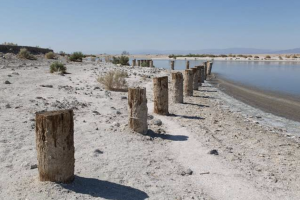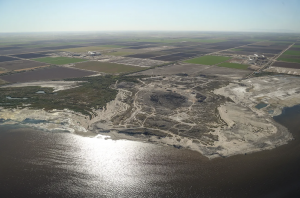
In many ways, the Salton Sea represents the current dilemma of the Imperial Valley. Originally created with water from the Colorado River, the Salton Sea has for years been contaminated with agricultural run-off, and is currently in the process of an environmental clean-up and restoration. But that farm water run-off may stop flowing, meaning the Salton Sea itself may cease to exist.
“You’ve got farmers using less water, and then less water going into the Salton Sea, [so] the sea shrinks,” says Sammy Roth, LA Times energy reporter.
The Imperial Valley finds itself at an inflection point. Farmers there are the biggest user of water from the Colorado River. But with less water available from the increasingly dry river, and seven other states with competing water rights, some farmers are pulling out their crops, and planting something else — solar panels.
“The future is uncertain with water, [and] solar is a reliable income stream,” explains Roth, who has been chronicling California’s transition to renewable energy sources. “They’ve got 17,000 acres of solar that are built down there. … It’s not a lot compared to 450,000 acres of farms … but it’s a significant amount and it’s growing.”
Aside from possibly causing the disappearance of the Salton Sea, transitioning from farming to solar energy production is threatening to wipe out a way of life in the region. It’s forcing difficult choices among farming families, many of whom have been in agriculture for generations.
“You have these fights that are starting to play out between agricultural landowners,” says Roth. “On the one hand, it’s climate benefits, it’s saving water on the Colorado, it’s generating income for some of the landowners. On the other hand, you’ve got plenty of farmers and also farm workers who see this as a threat to their way of life, [and] a threat to the agricultural economy.”
Complicating the decision is decades of mistrust that has been built up between rural communities and urban areas over water. Imperial Valley farmers have been growing food, especially winter vegetables, that feed the nation, and are sold for export. But as they’ve grown in population, urban areas like LA have demanded more water from rural areas.
“Cities are going to continue to grow,“ explains Roth. “One way or another, we’re going to have to figure out a way to bridge some of these trust gaps or things are not going to work out well for anybody.”
There are possible benefits for farmers who have switched, says Roth. There is the potential to make more money harnessing solar power than growing crops, however it depends on the kinds of crops historically grown on a piece of land, as well as the quality of soil and availability of water. Aside from winter vegetables, the Imperial Valley also grows alfalfa and grass for livestock, which adds nuance to the argument that farmers are feeding the nation.
“Many of us eat dairy, eat beef, the stuff that comes from cattle,” says Roth, alluding to the higher environmental costs that come from choosing an animal-based diet. “[Growing alfalfa] is not quite the same as growing food directly.”
Whichever choice farmers make — continue farming or switch to solar — the contaminated Salton Sea figures into the complicated dynamics of the region in an increasingly warming climate, says the LA Times’ Sammy Roth.
“How do you address the impact of that on the Salton Sea and not … let it become worse and worse for the wildlife that depend on it? And for the people who are going to be breathing dirtier air if the sea continues to shrink?”









